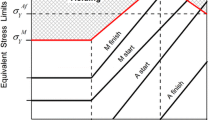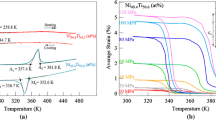Abstract
The influence of applied stresses and imposed plastic deformation on the martensitic transformation of a parent phase is described. Changes in mechanical properties such as flow stress, work hardening rate, fracture toughness, etc brought about by strain-induced martensitic transformation are briefly examined. In the absence of appreciable dislocation glide, atomic displacements associated with glissile boundaries are highly ordered and reversible modes of (plastic or nonlinear pseudoelastic) deformation. Such processes lead to large strains and are encountered in deformation twinning, martensitic transformations and in the reorientation of martensite units. The reversibility leads to phenomena such as elastic twinning, thermoelastic martensites, superelasticity, shape memory and two-way shape memory effects, and rubber-like behaviour. These are discussed using a unified approach based on thermoelastic equilibrium. The shape memory effect suggests several potential applications of the martensitic transformations in non-ferrous alloys in which the effect is most commonly observed. Recent developments in this area are reviewed with special reference to the prerequisites for the effect and the influence of metallurgical processing on the extent of shape recovery.
Similar content being viewed by others
References
Angel T 1954J. Iron Steel Inst. 177 165
Bowles J S and Mackenzie J D 1954Acta Metall. 2 129
Chang L C and Read T A 1951Trans. Met. Soc. AIME 191 47
Cook J M 1981 Ph.D. Thesis, Cambridge University (unpublished)
Christian J W 1982Met. Trans. A13 509
Delaey L, Krishnan R V, Tas H and Warlimont H 1974J. Mater. Sci. 9 1521
Delaey L and Warlimont H 1975Proc. conf. shape memory effects in alloys, (eds) J Perkins (New York: Plenum Press) p. 59
Divers C K 1964Met. Prog. 86 115
Dunne D P and Wayman C M 1973Met. Trans. 4 137
Krishnan R V, Delaey L, Tas H and Warlimont H 1974J. Mater. Sci. 9 1536
Ling H S and Owen W S 1979Proc. int. conf martensitic transformation (ICOMAT 1979), (Cambridge: MA) p. 368
Ludwigson D C and Berger J A 1969J. Iron Steel Inst. 207 63
Mangonon P L Jr and Thomas G 1970Met. Trans. 1 1587
Murr L E, Staudhammer K P and Heeker S S 1982Met. Trans. A13 627
Olsen G B and Cohen M 1972J. Less Common Metals 28 107
Olsen G B and Cohen M 1975Met. Trans. A6 791
Olsen G B and Cohen M 1976Met. Trans. A7 1905
Olander A 1932J. Am. Chem. Soc. 54 3819
Onodera H and Tamura I 1979 US-Japan seminar onMechanical behaviour of metals and alloys associated with displacive transformation, (Troy, NY) p. 24
Patel J R and Cohen M 1953Acta Metall. 1 531
Seetharaman V 1976Effect of thermomechanical treatments in stainless steels M.Sc. (Tech) Thesis, University of Bombay
Seetharaman V and Krishnan R 1981J. Mater. Sci. 16 523
Suzuki T, Kojima H, Suzuki K, Hashimoto T and Ichihara H 1977Acta Metall. 25 1162
Tamura I 1982Met. Sci. 16 245
Tamura I, Maki T and Hato H 1970aTrans. Iron Steel Inst. Jpn 10 163
Tamura I, Maki K, Hato H, Tomoto Y and Okada M 1970bProc. ICSM A 3, (ASM, Metals Park Ohio) p. 900
Tong H C and Wayman C M 1975Acta Metall. 23 209
Wasilewski R J 1975Met. Trans. A6 1405
Wayman C M 1964Introduction to the crystallography of martensitic transformation (London: Macmillan)
Wayman C M and Shimizu K 1972Met. Sci. J. 6 175
Wechsler M S, Lieberman D S and Read T A 1953Trans. AIME 197 1503
Zaekay V F, Parker E R, Fahr D and Busch R 1967Trans. ASM 60 252
Zener C 1947Phys. Rev. 71 846
Author information
Authors and Affiliations
Rights and permissions
About this article
Cite this article
Seetharaman, V. Deformation and martensitic transformation. Bull. Mater. Sci. 6, 703–716 (1984). https://doi.org/10.1007/BF02743999
Issue Date:
DOI: https://doi.org/10.1007/BF02743999




